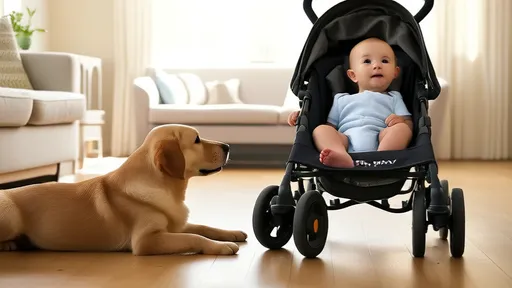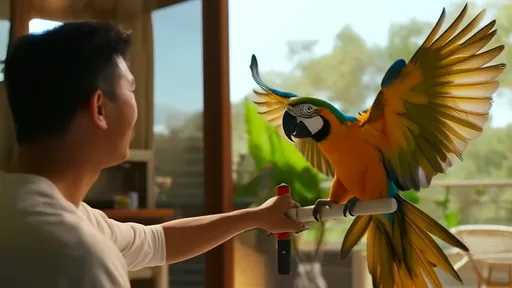In households where furry friends and tiny humans coexist, establishing safe interaction boundaries becomes paramount. The delicate dance between a curious toddler and an affectionate pet requires thoughtful supervision and proactive measures. While the companionship between children and animals can foster empathy and joy, physical proximity demands careful consideration to prevent accidental scratches, bites, or overwhelming encounters.
The concept of safe interaction distance varies significantly depending on the pet's species, temperament, and the child's developmental stage. A crawling infant exploring the world with grabby hands presents different challenges than a preschooler who might chase the family cat. Similarly, an elderly dog with arthritis may need more personal space than an energetic puppy. These dynamics require parents to become fluent in interpreting body language from both their child and pet to identify when boundaries are being crossed.
Veterinary behaviorists emphasize that physical distance alone doesn't guarantee safety - the quality of interaction matters profoundly. A dog lying three feet away from a baby but showing whale eye (visible whites of the eyes) and lip-licking is actually in distress, despite the apparent adequate spacing. Conversely, a cat voluntarily approaching a child for gentle petting at close range may represent an appropriate interaction when supervised. This nuance underscores why simple distance rules fail to capture the complexity of interspecies communication.
Sleeping and eating areas create critical zones requiring special consideration. Pets often perceive these spaces as sacred territory, and children must learn to respect these animal sanctuaries. The American Academy of Pediatrics recommends maintaining physical barriers between pets and infants during sleep times, as even the most docile animal might react unpredictably to sudden movements or noises. Similarly, mealtimes for both parties should remain separate to avoid food-guarding incidents or choking hazards from dropped human food.
Environmental design plays a crucial role in facilitating positive interactions. Creating elevated retreat spaces for cats (like wall shelves or tall cat trees) allows them to observe children from a safe vantage point. For dogs, baby gates can establish clear boundaries where the pet can retreat when needing space. These adaptations help animals maintain autonomy over their personal space while allowing visual contact that maintains the human-animal bond. Interestingly, research shows that pets given control over interaction distance demonstrate lower stress hormones and more voluntary positive engagement with children.
The developmental trajectory of children introduces evolving safety considerations. Mobile infants who discover tail-pulling require constant supervision, while preschoolers learning empathy can be taught to recognize when animals need space. School-aged children often develop more sophisticated understanding of animal behavior, allowing for closer interaction under guidance. This progression means that safe distances aren't static but should adapt as the child matures and the human-animal relationship deepens.
Unexpected situations demand particular vigilance. When pets become frightened by loud noises (thunderstorms or dropped pans) or experience pain (from arthritis or accidental stepping), their tolerance for proximity may suddenly decrease. Similarly, toddlers in the midst of tantrums or overly excited children at playdates may forget gentle hands. These scenarios warrant increased distance or temporary separation until all parties regain calm. Animal shelters report that most bites to children occur during such emotionally charged moments when standard interaction rules break down.
Cultural perspectives on child-pet proximity reveal fascinating variations. Some European countries encourage very close bonds, with pets often sharing sleeping spaces with infants under careful conditions. In contrast, other traditions maintain more separation until children reach certain ages. Modern research suggests finding a middle ground - neither complete isolation nor unrestricted access, but rather structured interaction zones that respect both species' needs. This approach acknowledges the mental health benefits of early human-animal bonding while prioritizing physical safety.
Technology offers new tools for monitoring safe interactions. Wearable devices for pets can track stress indicators like elevated heart rate, alerting parents before problematic situations escalate. Motion-activated cameras help supervise interactions when direct observation isn't possible. However, experts caution that these should supplement rather than replace hands-on supervision, especially with very young children. The most effective safety strategy combines environmental management, education about animal behavior, and attentive adult presence during all interactions.
Ultimately, crafting a harmonious household with pets and children resembles an ongoing conversation rather than setting rigid rules. As both the animal and child grow and change, so too must the approaches to their interactions. By cultivating mutual respect and understanding between species, families can nurture bonds that enrich childhood while keeping all members - furry and otherwise - safe and content in shared spaces.

By /Jul 24, 2025

By /Jul 24, 2025

By /Jul 24, 2025

By /Jul 24, 2025

By /Jul 24, 2025

By /Jul 24, 2025

By /Jul 24, 2025

By /Jul 24, 2025

By /Jul 24, 2025

By /Jul 24, 2025

By /Jul 24, 2025

By /Jul 24, 2025

By /Jul 24, 2025

By /Jul 24, 2025

By /Jul 24, 2025

By /Jul 24, 2025

By /Jul 24, 2025

By /Jul 24, 2025